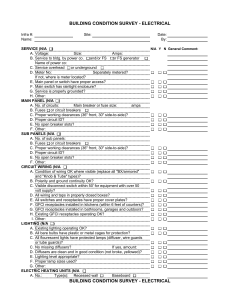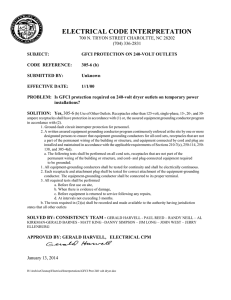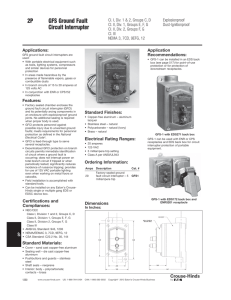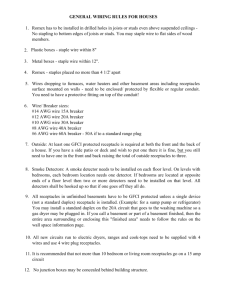Ten Deadly Conditions to Check for in Your
advertisement
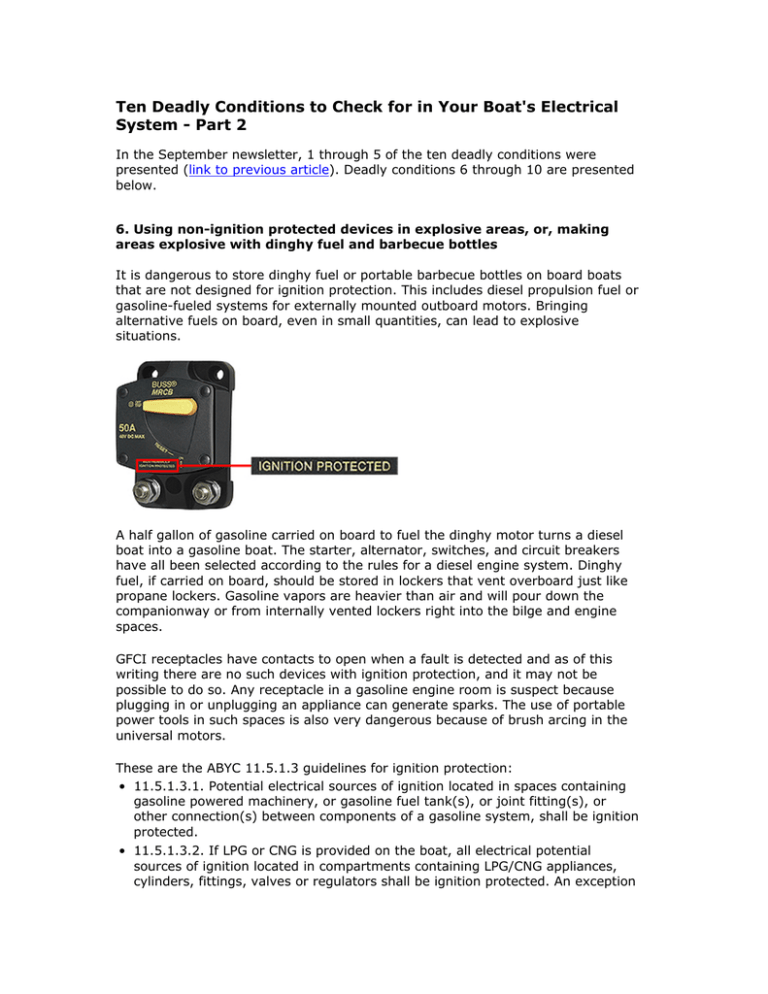
Ten Deadly Conditions to Check for in Your Boat's Electrical System - Part 2 In the September newsletter, 1 through 5 of the ten deadly conditions were presented (link to previous article). Deadly conditions 6 through 10 are presented below. 6. Using non-ignition protected devices in explosive areas, or, making areas explosive with dinghy fuel and barbecue bottles It is dangerous to store dinghy fuel or portable barbecue bottles on board boats that are not designed for ignition protection. This includes diesel propulsion fuel or gasoline-fueled systems for externally mounted outboard motors. Bringing alternative fuels on board, even in small quantities, can lead to explosive situations. A half gallon of gasoline carried on board to fuel the dinghy motor turns a diesel boat into a gasoline boat. The starter, alternator, switches, and circuit breakers have all been selected according to the rules for a diesel engine system. Dinghy fuel, if carried on board, should be stored in lockers that vent overboard just like propane lockers. Gasoline vapors are heavier than air and will pour down the companionway or from internally vented lockers right into the bilge and engine spaces. GFCI receptacles have contacts to open when a fault is detected and as of this writing there are no such devices with ignition protection, and it may not be possible to do so. Any receptacle in a gasoline engine room is suspect because plugging in or unplugging an appliance can generate sparks. The use of portable power tools in such spaces is also very dangerous because of brush arcing in the universal motors. These are the ABYC 11.5.1.3 guidelines for ignition protection: • 11.5.1.3.1. Potential electrical sources of ignition located in spaces containing gasoline powered machinery, or gasoline fuel tank(s), or joint fitting(s), or other connection(s) between components of a gasoline system, shall be ignition protected. • 11.5.1.3.2. If LPG or CNG is provided on the boat, all electrical potential sources of ignition located in compartments containing LPG/CNG appliances, cylinders, fittings, valves or regulators shall be ignition protected. An exception is made for open compartments and accommodation spaces if everything is installed according to ABYC- A-1, ABYC A-33 and ABYC A-3 for gas systems and appliances. 7. Hot/Neutral reversal on AC connectors at the dock or onboard If a shore cord is incorrectly wired so that the hot and neutral wires are reversed, there is inadequate AC circuit protection. Your boat should have a two pole main breaker if wired for 120V. It should also have a reverse polarity indicator or warning device. The power companies have developed a standard for 120-volt single-phase power distribution in which one of the two conductors is designated the "hot" wire (the black wire in North America) and the other, by default, the neutral (the white wire). However, neither power conductor in an AC system is permanently at either a positive or a negative potential. Their respective potentials alternate between zero, the maximum positive, zero, and the maximum negative potential. This is what makes it AC. If a shore cord is incorrectly wired so that the hot and neutral wires are reversed, the "new" hot line now has no overcurrent protection because the branch circuit wiring is only protected by a 30 or 50 ampere main circuit breaker. Worse, turning off the branch circuit breaker leaves the circuit hot. The circuit breaker does turn the load on and off, so all seems normal. This leads to several possible hazards: • The branch circuit wires are only protected by the larger main circuit breaker in the event of a failure of the white wire to ground. • Anyone working on the wiring and turning off the branch circuit breaker will still be in contact with a live wire if the main breaker isn't off. This can be a serious shock hazard. • The outer shell of conventional screw in light bulbs is intended to be the neutral conductor with a voltage near ground. Any broken bulb is dangerous to remove when energized, and reverse polarity makes it worse. • Boats not wired to present-day ABYC standards may have only a single pole main breaker and no reverse polarity lights to indicate a reverse polarity fault. This can occur in internal wiring or more probably in marina wiring that is not performed correctly. Private docks, and some commercial docks, may not always be wired by skilled electricians and properly inspected. Your boat should have a two pole main breaker if wired for 120V. It should also have a reverse polarity indicator or warning device. A three pole breaker is appropriate for the main breaker in a 120/240V system, because neutral faults can also exist in these systems, with either an open neutral or reverse polarity generating hazards or damage to equipment. 8. Undersized or absent inverter and charger DC grounding Inverters and battery chargers are bridges between a boat's AC and DC power systems. The high voltage of the AC system presents a shock hazard and can be lethal if it exists on an ungrounded case. The DC system is not normally a shock hazard but can provide a lot of current, and so is potentially a source of fire. A suitable ground must be installed between the AC and DC system. Inverters and changers are provided with grounding connections on both the AC side and DC side. This grounding can prevent shocks from AC, and fire hazard from DC. Frequently only the AC grounding connection is made. A fault in the DC side of the system could provide enough current to overheat the AC grounding conductor without blowing the large DC fuse. Therefore, a high amperage capacity DC grounding path back to the DC system is required. There is no mention of adequate measures to wire inverters and chargers in ABYC E-11 where most guidelines for electrical systems are found, so knowledge of proper installation is readily overlooked. This information is actually contained in ABYC A-25 for inverters, and A-24 for chargers. Because this hazard has only recently been recognized, the installation instructions for older generation inverters typically do not include this precaution, but most newly designed units do. You may buy a "new" inverter from off the dealer shelf today and not get the proper information because the instructions may have been written a few years ago. For example, the instructions for a newly introduced inverter recommend a 2/0 cable for a 3 KVA inverter, but the instructions from the same manufacturer on their older models give no recommendation at all. Follow these general guidelines for wiring inverters and chargers: • The ground wire to the DC grounding system should not be smaller than one size below the wire size required for the DC current carrying conductors. • The DC overcurrent protection device should not be sized at more than 150% of the capacity of the grounding conductor. 9. Missing or faulty GFCI According to the ABYC Standards, when an AC receptacle is installed in a head, galley, machinery space, or on a weather deck, it shall be protected by a Type A Ground Fault Circuit Interrupter (GFCI). These GFCI's protect receptacles and therefore the appliances that are plugged into them. It is possible to use the output of one GFCI receptacle to feed other receptacles and permanently-wired devices thereby protecting these downstream receptacles and devices. According to ABYC 11.15.3.5, when an AC receptacle is installed in a head, galley, machinery space, or on a weather deck, it shall be protected by a Type A (nominal 5 milliamperes) Ground Fault Circuit Interrupter (GFCI). (There is a little natural imbalance from the tiny radiation from an AC system, so the limit at 5mA is set below a safe threshold for humans. If it were zero it would be tripping unnecessarily.) GFCI devices compare the current flowing in the hot (black) wire and the neutral (white) wire. If all of the current going out does not come back on the paired conductor, it is going somewhere not intended, and that might be through a person! In this condition, the GFCI will trip. The ABYC Standards call for GFCI's to protect receptacles and therefore the appliances that are plugged into the receptacle. However, the Standards do not require GFCI's for permanently-wired appliances such as hot water heaters, space heaters, battery chargers, air conditioners, etc. These devices are assumed to be protected by a solid safety ground connection to the case. However, it is good practice to also protect these devices with GFCI's. It is possible to use the output of one GFCI receptacle to feed other receptacles and permanently wired devices. By doing so, you can choose to provide more protection than the minimum in the ABYC Standard. GFCI's should be tested frequently, especially in areas subject to lightning or if there has been any electrical malfunction onboard. Because of the corrosive atmosphere of the marine environment, these devices may have a shorter life span on a boat than they have ashore. 10. Operating power tools in potentially explosive atmospheres Portable power tools operated by batteries or by AC have brush-type universal or DC motors. The spinning commutator generates sparks and the space is usually well ventilated and even has a fan forcing outside air through the space. Electric drills, routers and saws are bad. Shop vacuums are worse. They are designed to collect air and dirt through the hose and bring it inside. The air passes through a filter and then some of it through the motor. More than one explosion has taken place when a wet/dry vacuum was used to vacuum up a fuel spill in the bilge. A shop vacuum is a wonderful way to pick up water spills, but it also excellent at mixing and igniting explosive gas. Nobody thinks about getting killed by a vacuum cleaner but it can take out the operator, the boat and possibly the neighbors!
